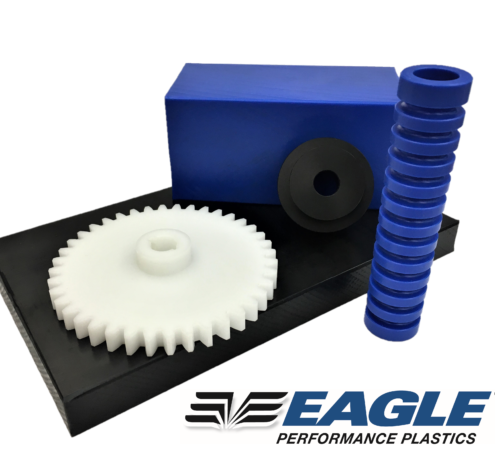Fluorosint 500

Overview
What is the Material: Fluorosint 500 is a semi-crystalline material and it is a modified PTFE (Teflon) filled with synthetic mica.
Key Material Features: This material is beneficial in applications requiring dimensional stability, low friction, chemical resistance, and wear resistance.
Other Considerations: Useful in applications where you need greater dimensional stability, hardness, and wear than other PTFE materials.
Physical
| Property | Value | Typical ASTM Test |
|---|---|---|
| Chemical Designation | (PTFE) Polytetrafluoroethylene | |
| Trade Names (®, ™) | Fluorosint 500 | |
| Filler | Mica | |
| Color | White | |
| Density (g/cm^3) | 2.32 | D 792 |
Mechanical
| Property | Value | Typical ASTM Test |
|---|---|---|
| Modulus of Elasticity (Tensile Test) (psi) | 300000 | D 638 |
| Tensile Strength at Yield (psi) | 1100 | D 638 |
| Elongation at Break (%) | 30 | D 638 |
| Flexural Strength (psi) | 2200 | D 790 |
| Modulus of Elasticity (Flexural Test) (psi) | 500000 | D 790 |
| Compression Strength: 10% Strain (psi) | 4000 | D 695 |
| Compression Modulus (psi) | 250000 | D 695 |
| Impact Strength (Izod) (ft-lbs/in) | 0.9 | D 256 |
| Hardness (R) | 55 | D 785 |
| Hardness (D) | 70 | D 785 |
| Coefficient of Friction (Kinetic, 40 psi, 50 fpm) | 0.15 | D 3702 |
Thermal
| Property | Value | Typical ASTM Test |
|---|---|---|
| Melting Point (°F) | 621 | D 3418 |
| Service Temperature Continuous (°F) | 500 | |
| Service Temperature Minimal (°F) | -328 | |
| Thermal Expansion (CLTE) (in/in/°F) | 2.50E-05 | D 696 |
Electrical
| Property | Value | Typical ASTM Test |
|---|---|---|
| Volume Resistivity (Ω*cm) | 1.00E13 | D 257 |
| Dielectric Strength (V/mil) | 275 | D 149 |
| Dissipation Factor (1MHz) | 0.008 | D 150 |
| Dielectric Constant (1MHz) | 2.85 | D 150 |
Other
| Property | Value | Typical ASTM Test |
|---|---|---|
| Moisture Absorption (%) (24 Hours) | 0.1 | D 570 |
| Moisture Absorption (%) (Saturated) | 0.3 | D 570 |
| Flammability | V-0 |
The data stated are typical values intended for reference and comparison purposes only. The data should not be used as a basis for design specifications or quality control. The information is provided as a guide to the best of our knowledge and given without obligation or liability. Testing under individual application circumstances is recommended.
